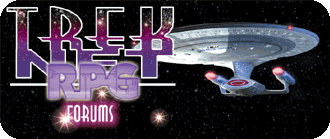I have never been overly concerned one way or the other regarding Dolphin or other cetacean characters. Recently however, while doing another project, I had a question about Cetaceans rolling around in my mind. Some vessels, like the Galaxy class, have cetacean sections, but what is the quality-of-life for these guys? I know that living full time at Seaworld would kind of suck too, but once you classify them as a sentient being and all, lets give them something meaningful to do, or see or something....
So how do you accomplish it? Here is one thing I thought of the other day:
--------------------------------------
APHIS
Captain’s Log...
I have received my first command with a Cetacean contingent on-board. I met ‘Charlie’, or at least Charlie’s ‘Portrait’, a few hours after coming on the USS Nemo, he seemed to me to be like any fresh-scrubbed cadet I had ever met – eager and frightened at the same time. When we shook hands I knew in my mind but never would have otherwise guessed that it was merely a photonic limb with the illusion of solidity and that ‘Charlie’, the real dolphin-crewman, was in the cetacean pool on Deck 7 strapped into this APHIS contraption...
APHIS (the Aquatic Personnel Holoprojection Interface System) was designed to allow Cetacean and other completely aquatic lifeforms to participate more fully in crew duties and everyday activities onboard Starfleet vessels. It does so by creating a holoprojection of the crewmember (known as a Portrait) linked directly to the aquatic individual via the APHIS hardware. As long as the Holoemitters are functioning, aquatics now have a place alongside the rest of the Crew in positions like Helm, Science and Medical.
APHIS consists of a Holographic interface and filtering software which creates a linkage with the cetacean subject (via contact electrodes in a special harness) and translates movement and communication from the aquatic into humanoid-equivalents. As some aquatics (like cetaceans) have much different organic design than humanoids, the ‘filter’ software works in both directions, providing the aquatic with equivalent kinesthetic sensations at the same time it translates the aquatics intentions of movement into ‘standard’ humanoid movement. Most cetaceans and other non-humanoid aquatics find the experience of having arms and legs somewhat strange, although many have been familiar with ‘waldo’ manipulator arms and other manipulators use as part of previous attempts to get these species out of the Cetacean-pools.
The result of this technological application is a holoprojected analogy (known as a Portrait) of the aquatic crewmember that is able to move about the ship (wherever Holoemitters have been installed), interact with other crewmembers and take part in crew duties. Each aquatic has a basic form designated by the APHIS software that provides some clue to humanoids what species they are dealing with (the appearance of Dolphins for example differs from other cetaceans). The specific facial likeness and somatotype of the Portrait is selected by the aquatic from computer-generated options (to avoid purposeful duplication of other another’s likeness). The program generally locks out the aquatic from making alterations to their own Portrait (although they certainly can hack in and do so and command personnel can disable this function for certain individuals and under certain conditions). Counselors have found that a consistent Portrait is very important to facilitate interaction with other crewmembers.
Continuous APHIS operations can safely be maintained for 12-15 hours. Continuous APHIS Operations longer than 15-20 hours are considered an unacceptable (although still moderately low) risk to user safety due to long-term neurostress; while continuous APHIS operation longer than 20 hours is considered potentially dangerous to the subject. Approximately 8-hours of rest are advised after APHIS operations (more if normal safety limits have been breached).
Thus far there are thirteen different Aquatic lifeforms which have been programmed into the APHIS filtering software and tested successfully under laboratory conditions. Dolphins and other cetacean subjects are at the leading edge of this technology, followed closely by semi-humanoid species like the Natallo which have fewer need for filtering software. Most of the aquatics taking part in any field-work using APHIS must have already taken part in ‘APHIS school’ at one of Starfleet’s facilities, giving them the valuable experience of moving about as a humanoid in a laboratory and non-vessel setting before they are placed on a starship. At ‘APHIS School’ (which some of the cetaceans have started to call ‘Dry College’) specialists in human-aquatic interaction, medical staff and counselors monitor the aquatic’s progress in this highly individualized program. For some, the experience takes a few weeks, others have either washed out (pardon the pun) of the program or have taken over a year to fully adapt to the system. Presently some late-arriving members of the APHIS design team are pushing for washing out those who do not manage to make significant progress after a certain period of time; long-time members complain that this enabling technology was designed to facilitate interaction for all aquatics independent of their individual potential for quick success.
APHIS is presently being field-tested onboard of the USS Cerberus and several other Nautilus Class vessels (which already have large cetacean areas). These programs generally use 6 aquatic crewmembers and 3 or 4 APHIS modules per ship. This setup provides two Portrait-assisted aquatic Crewmembers for each duty shift and a four hour period of ‘off-duty interaction’ for each aquatic (either before or after the dutyshift).
-------------------------------------
Mad Political Scientist
[This message has been edited by Publius (edited 08-08-2001).]
